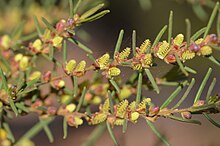| Bertya | |
|---|---|
 | |
| Bertya gummifera | |
| Scientific classification | |
| Kingdom: | Plantae |
| Clade: | Tracheophytes |
| Clade: | Angiosperms |
| Clade: | Eudicots |
| Clade: | Rosids |
| Order: | Malpighiales |
| Family: | Euphorbiaceae |
| Subfamily: | Crotonoideae |
| Tribe: | Ricinocarpeae |
| Subtribe: | Bertyinae |
| Genus: | Bertya Planch. [1] |
Bertya is a genus of flowering plants in the family Euphorbiaceae endemic to Australia. Plants in the genus Bertya are shrubs, usually monoecious, with simple leaves, flowers arranged singly in leaf axils, male flowers with many stamens, female flowers usually smaller and narrower than male flowers, and the fruit a capsule containing a single seed.